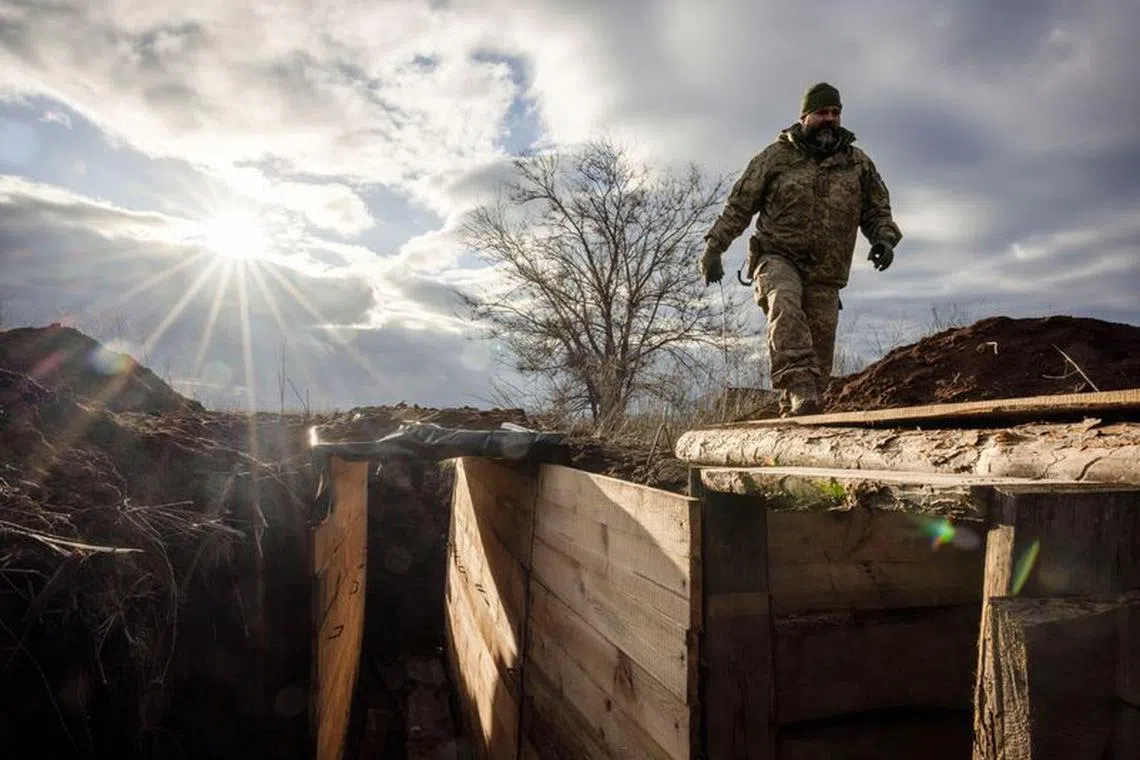Ukraine builds barricades, digs trenches as focus shifts to defence
Sign up now: Get ST's newsletters delivered to your inbox

The defences aim to help Ukraine weather assaults while regenerating its forces as Russia takes the battlefield initiative, military analysts said.
PHOTO: REUTERS
Follow topic:
NEAR KUPIANSK, Ukraine – Rows of white concrete barricades and coils of razor wire stretch across an open field for more than a kilometre.
Trenches with rudimentary living quarters are being dug under cover of darkness. Artillery rumbles not far away.
New defensive lines near the north-eastern city of Kupiansk on Dec 28 show how Ukraine has stepped up construction of fortifications in recent months as it shifts its military operations against Russia to a more defensive footing.
The defences, which bear some similarities to those rolled out in the Russian-occupied south and east, aim to help Ukraine weather assaults while regenerating its forces as Moscow takes the battlefield initiative, military analysts said.
“As soon as the troops are moving, traversing fields, you can do without fortifications,” a Ukrainian army engineer with the call sign “Lynx” said near Kupiansk.
“But when the troops stop, you need to immediately dig into the ground.”
President Volodymyr Zelensky announced that Ukraine was “significantly enhancing” fortifications on Nov 28 after a counteroffensive that it launched in June was unable to rapidly punch through Russian lines.
Kyiv says it is unswayed in its ambition to retake all remaining occupied territory, but is for now focused on politically sensitive conscription reforms to replenish manpower while also addressing artillery shortages at the front.
Russia has been ramping up offensive pressure around eastern towns such as Kupiansk, Lyman and Avdiivka, and no longer needs to hold back its reserve troops for fear of a possible Ukrainian breakthrough, the military analysts said.
Mr Zelensky said Ukraine’s defensive constructions needed to be boosted, and work on them accelerated around the three towns, in eastern parts of the Donetsk region, and in the regions of Kharkiv, Sumy, Chernihiv, Kyiv, Rivne and Volyn.
Those regions stretch all the way up from Ukraine’s east, along the border with Russia and Belarus, to its Western ally Poland.
Mr Zelensky said the southern Kherson region, a swathe of which is still occupied, would also be reinforced.
Defensive posture
There is no publicly available data for the intensity or scale of the fortification construction.
Ukraine has had defensive lines in some areas of the eastern Donbas region since 2014, when Russia backed militants seized territory.
It has been heavily dug in in places such as Avdiivka throughout the full-scale invasion.
Stronger fortifications would slow down Russian troops and suck fewer Ukrainian forces into defence, freeing them up from the front so they could, for instance, receive more training, said senior research fellow for land warfare Jack Watling of the Royal United Services Institute think-tank.
“The Ukrainians are now shifting onto a defensive posture because their offensive has culminated,” he said in a phone interview, adding that Russia had retaken the initiative on the battlefield and was able to choose where to attack.
With Ukrainian artillery ammunition stocks declining, the rate of Russian casualties was falling, making it easier for Moscow to generate new units, which in time could allow it to open up new lines of attack, he added.
“On the Ukrainian side, they are trying to minimise their own casualties, but also regenerate offensive combat power,” said Dr Watling.
He said fortifications could also be used to defend Ukraine’s flanks when it goes back on the offensive.
Dragon’s teeth
On Jan 10, reporters visited trenches being dug with an excavator and shovels at an undisclosed location in the Chernihiv region near the Russian border.
“When the civilians have done their job (building the positions), we will densely mine it,” Lieutenant-General Serhiy Nayev, Ukraine’s joint forces commander, who oversees the northern military sector, told reporters at the site.
In December, reporters visited newly built Ukrainian trenches in Chernobyl near the border with Belarus, a Russian ally used by Moscow as a staging ground for the February 2022 invasion.
A large military engineering vehicle churned through the snowy ground as it carved out a wide anti-tank ditch.
“(The works are ongoing) along the whole northern operational zone. These works are currently under way in Sumy region, Chernihiv region, here in the Kyiv direction,” Lt-Gen Nayev said at the site.
“Concrete structures, barbed wire... ‘dragon’s teeth’ (concrete barricades); they will be mined and barbed wire will be put on them. This will be a continuous concrete obstacle for armoured vehicles,” he said.
Near Kupiansk, Ukraine’s military showed reporters newly built defensive lines, but said the exact location could not be disclosed publicly for security reasons.
A military engineer using the call sign “Lizard” said they typically put down the dragon’s teeth first, followed by coils of razor wire and then mines, if they use them.
“I believe most of these barriers should have been built much earlier, probably in the spring. It takes too much time,” he said.
Several hundred metres behind the dragon’s teeth, work was under way to expand a network of personnel trenches reinforced with wooden beams, where there were also living quarters and wooden bunk beds.
Lynx, the other serviceman, said Ukraine was trying to minimise the use of mines for its fortifications to avoid leaving dangerous munitions on its territory.
“This is our land. We wouldn’t want to litter it so much,” he said. REUTERS

